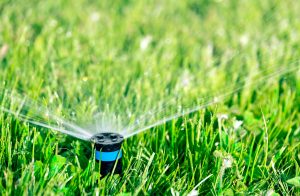Fall & Winter Lawn Watering Tips
Metro Orlando FL | Kissimmee - Sanford - Leesburg
 Watering in fall isn’t much different from watering at any other time of year. The main difference is that as the weather cools off, you may notice that the lawn will go into dormancy, which means that the growing season will come to an end. The lawn’s color will change, its growth will slow down and eventually stop as winter approaches. Because of this, your watering frequency must change. At the beginning of the fall, continuing to water twice a week is ok. Eventually, you may be instructed by your neighborhood to cut back your watering to a maximum of once per week. And provided that your lawn has been watered correctly up to that point, one watering cycle a week will generally keep the grass in good shape. Because proper watering every season is so important, we have provided you with some very important steps that you can follow to ensure that your lawn stays healthy through this season and into the next. If you need help or advice, we are always here to answer any irrigation questions that you may have.
Watering in fall isn’t much different from watering at any other time of year. The main difference is that as the weather cools off, you may notice that the lawn will go into dormancy, which means that the growing season will come to an end. The lawn’s color will change, its growth will slow down and eventually stop as winter approaches. Because of this, your watering frequency must change. At the beginning of the fall, continuing to water twice a week is ok. Eventually, you may be instructed by your neighborhood to cut back your watering to a maximum of once per week. And provided that your lawn has been watered correctly up to that point, one watering cycle a week will generally keep the grass in good shape. Because proper watering every season is so important, we have provided you with some very important steps that you can follow to ensure that your lawn stays healthy through this season and into the next. If you need help or advice, we are always here to answer any irrigation questions that you may have.
CHECK YOUR IRRIGATION SYSTEM EARLY IN THE SEASON
Did you know that having a properly running sprinkler system is just as important to your lawn’s health as fertilization? If your system is not watering properly or if your lawn is receiving improper coverage, areas of your turf can go into severe drought rather quickly and can cause irreversible damage. Having your sprinkler system checked by a professional will not only ensure that all heads are functioning properly but doing so will also ensure that all zones in your lawn have a good head to head coverage. Remember, even if your lawn is being properly fertilized, nothing will keep your lawn healthy if your sprinkler system is not watering your lawn correctly.
HOW OFTEN SHOULD YOU WATER YOUR LAWN?
There is really no set schedule to watering your lawn in fall and winter. Compared to the summertime, your lawn will require less water due to temperatures being on the cooler side. At the beginning of fall, when temperatures are still on the warmer side, continuing to water twice a week should be fine. As the temperatures drop in late fall to early winter, your watering frequency will likely change to once per week. Your neighborhood or local water company may even alert you when it is time to do this. However, if they do not, a good way to know when it’s time to water in the fall is to simply keep an eye on your lawn.
Because temperatures are cooler and water will not evaporate as quickly as it would in the summer, you definitely DO NOT want to overwater your lawn by continuing to water it twice a week when it doesn’t need it. Your grass will tell you when it needs to be watered by either showing signs of wilt or by its color changing. You will notice that your lawn’s leaf blades will fold in half lengthwise and will begin to appear bluish grey when it’s in need of water. Those signs are your lawn telling you that it’s thirsty! Another indicator is to check your lawn for water retention. You can do this by simply walking in your lawn if your footprints remain in the lawn long after you’ve walked on it; the soil in your lawn has an abundance of moisture and does not need to be watered at that time. Overwatering your lawn can result in the growth of aquatic weeds such as dollar weed and sedge.
Ready for your INSTANT quote?
Click the button below to leave your information and we’ll be in touch with a free quote!
WHEN IS THE PROPER TIME TO WATER YOUR LAWN? AND HOW MUCH SHOULD YOU WATER?
The proper time to water is in the early morning around 3 am, before sunrise and after the dew has formed. You should be finished watering no later than 9:00 a.m. This can easily be done by setting your irrigation system’s clock to the appropriate time. Also, each zone should receive about ¾” of water. Providing your lawn with ¾” of water per zone will ensure that it is getting enough moisture to wet at least 8 – 12 inches of its root system, which is imperative to its growth and root development. You can measure the amount of water by placing empty irrigation measuring cups in each zone of your yard. Calculate how long it takes for the cup to be filled to 3/4-1″. This is the length of time you should set your clock’s watering time to run for. Watering at the proper time and at the right amount helps reduce fungus, evaporation, and wasted water. These recommendations are based on no watering restrictions. Please adhere to your local ordinances.
LOCALIZED DRY SPOTS IN YOUR YARD
During the fall, precipitation may decrease. In times of dry conditions, you may see brown areas develop. If this happens, simply check the sprinkler heads in those areas. Brown spots may signify that there is a broken head or an adjustment needed. Do not rely on seeing the water hit those areas. You must use a cylindrical container to ensure ¾” of water is being applied per zone and then make any necessary adjustments to ensure more uniform coverage. If you have a broken head, simply replace the head and then re-adjust as necessary. With proper head to head coverage, dry spots should be a thing of the past. If you need assistance, our irrigation technicians will be more than happy to perform a Free 7 Point Irrigation Analysis to check every zone for proper coverage.
HOW TO WATER YOUR LAWN DURING A FREEZE
Even though temperatures do not often drop below freezing in Florida, we still have short periods of cold weather and the occasional freeze. During these times, it’s important for you to know how to protect your lawn. One important reminder is that your lawn must be dry at the onset of sub-freezing temperatures. Do NOT water during a freeze. Doing so can cause substantial damage to the grass. However, if a freeze is on the way, watering the night before the freeze arrives can help your lawn. The water will seep into the soil and insulate the root structure of the grass, decreasing the potential for cold injury.
Back to Sprinkler System Maintenance

